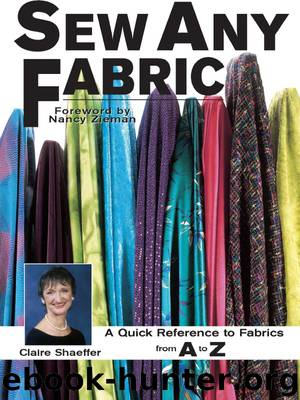Sew Any Fabric by Claire Shaeffer

Author:Claire Shaeffer
Language: eng
Format: epub
Tags: ebook, book
Publisher: F+W Media, Inc.
Published: 2011-02-25T05:00:00+00:00
Soft and silky, this summer shell is practical and easy to sew.(Burda Pattern – 8804, photo courtesy of Burda.)
Silk Suiting
Above Average
Silk suitings range from firmly woven shantungs to unique loosely woven tweeds. Many are bulky with slubs, thick ribs, and long floats which make them pick, pull, and ravel badly.
Workroom Secrets
Layout/Cutting/Marking: Many silk suitings stretch badly. Do not allow them to hang off the table when cutting. Use weights, temporary pattern adhesive, or flower pins. To match patterns, use single layer and duplicate pattern pieces. For fabrics which fray badly, cut 1" (2.5cm) seams. Before moving the sections, spray cut edges lightly with seam sealant, thin solution of white glue and water, or spray starch.
Use small safety pins to mark the right side of the fabric and construction symbols.
Stitching: To prevent underlayer creep, use a roller or even feed foot, hold the fabric firmly in front and behind the presser foot. Stitch several inches, then rest; raise and lower the foot; and stitch again. Tissue stitch seams as needed. Use polyester thread and a narrow zigzag (W,.5-L,2) for more elastic seams.
Seams: Stabilize necklines, shoulder seams, buttonholes, and zipper openings with stay tape. (See Any Fabric.) When it is difficult to match fabric patterns, piped seams are a good choice.
Seam/Hem Finishes: If the fabric frays badly, serge or bind seams before assembling. Work carefully to avoid changing or varying the seam allowance widths. On unlined garments, finish quality garments with a Hong Kong finish using silk chiffon or China silk. Use tricot bindings on everyday designs. Avoid double-fold bias bindings; they are too bulky and may show through.
Buttonholes: For more definition on machine stitched buttonholes, use water soluble stabilizer on top of fabric and/or cord the buttonholes. Underlinings: Use sew ins for stability and lightweight fusibles for added structure. sew in underlinings are more tactile than fusibles.
Pressing: To avoid flattening the fabric, cover pressing surface with thick terry towel. Use a press cloth to prevent iron from snagging fabric.
Download
This site does not store any files on its server. We only index and link to content provided by other sites. Please contact the content providers to delete copyright contents if any and email us, we'll remove relevant links or contents immediately.
On Writing A Memoir of the Craft by Stephen King(4666)
The Doodle Revolution by Sunni Brown(4504)
A Simplified Life by Emily Ley(3970)
Mummy Knew by Lisa James(3521)
Marijuana Grower's Handbook by Ed Rosenthal(3512)
Better Homes and Gardens New Cookbook by Better Homes & Gardens(3371)
Paper Parties by Erin Hung(3309)
Figure Drawing for Artists by Steve Huston(3272)
Draw Your Day by Samantha Dion Baker(3127)
The Genius of Japanese Carpentry by Azby Brown(3040)
Japanese Design by Patricia J. Graham(3002)
The Code Book by Simon Singh(2858)
Lions and Lace by Meagan Mckinney(2846)
Dangerous Girls by Haas Abigail(2840)
The Curated Closet by Anuschka Rees(2803)
How to Make Your Own Soap by Sally Hornsey(2742)
The Checklist Manifesto by Atul Gawande(2658)
The Wardrobe Wakeup by Lois Joy Johnson(2635)
Zero to Make by David Lang(2628)
